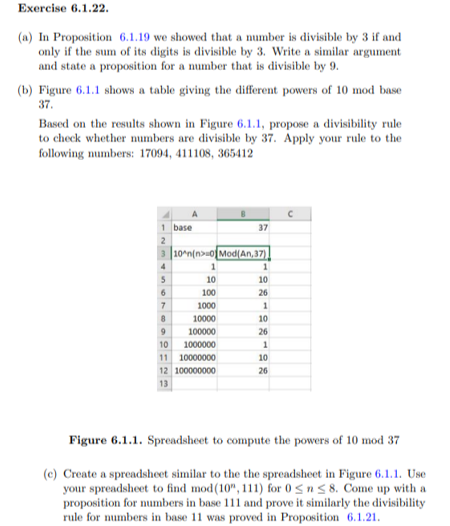Proposition 6.1.21. A number is divisible by 11 if and only if the alternat- ing sums of the digits is divisible by 11. (Note: alternating sums is where the signs of the number alternate when summing.) PROOF. Given an integer with digits do . dn where the number is writeen as dndn-1...d1do we can write n = dm · 10" + dm-1 · 10m-1 +...+ do · 10º it follows that: mod (n, 11) = mod (dm · 10m + dm-1 · 10m-1 + ..+ do · 10º, 11) = mod (dm · (-1)™ + dm-1 · (-1)"m-1 + ... = mod ((-1)"(dm – dm-1+ ·· [substitution] + do · (–1)º, 11) [mod(10, 11) = –1] + do · 1), 11) [factor out (-1)"] Therefore, mod (n, 11)=0 if and only if the alternating sums of the digits of
Proposition 6.1.21. A number is divisible by 11 if and only if the alternat- ing sums of the digits is divisible by 11. (Note: alternating sums is where the signs of the number alternate when summing.) PROOF. Given an integer with digits do . dn where the number is writeen as dndn-1...d1do we can write n = dm · 10" + dm-1 · 10m-1 +...+ do · 10º it follows that: mod (n, 11) = mod (dm · 10m + dm-1 · 10m-1 + ..+ do · 10º, 11) = mod (dm · (-1)™ + dm-1 · (-1)"m-1 + ... = mod ((-1)"(dm – dm-1+ ·· [substitution] + do · (–1)º, 11) [mod(10, 11) = –1] + do · 1), 11) [factor out (-1)"] Therefore, mod (n, 11)=0 if and only if the alternating sums of the digits of
College Algebra (MindTap Course List)
12th Edition
ISBN:9781305652231
Author:R. David Gustafson, Jeff Hughes
Publisher:R. David Gustafson, Jeff Hughes
Chapter8: Sequences, Series, And Probability
Section8.5: Mathematical Induction
Problem 37E
Related questions
Question
Please do Exercise 6.1.22 part abc and please show step by step
![Proposition 6.1.19. An integer is divisible by 3 if and only if the sum of
its digits is divisible by 3.
Proposition 6.1.21. A number is divisible by 11 if and only if the alternat-
ing sums of the digits is divisible by 11. (Note: alternating sums is where
the signs of the number alternate when summing.)
PROOF. Given an integer with digits do ... dn where the number is writeen
as dndn-1...dıdo we can write
n = dm · 10" + dm-1 · 10m-1 + ...+ do · 10º
it follows that:
mod (n, 11)
= mod (dm · 10" + dm-1· 10m–1 +...+ do · 10°, 11)
= mod(dm · (-1)™ + dm-1 · (–1)m-1+.
= mod ((-1)" (dm – dm-1+ ·+do · 1), 11)
[substitution]
..+ do · (–1)º, 11) [mod(10,11) = -1]
[factor out (-1)"]
...
Therefore, mod (n, 11)=0 if and only if the alternating sums of the digits of
the number d, ... do is divisible by 11.](/v2/_next/image?url=https%3A%2F%2Fcontent.bartleby.com%2Fqna-images%2Fquestion%2F892e817a-9b32-4eeb-b8fc-5dd7ffde6479%2F7ecb53a8-32c8-41ee-ae64-6480991310a9%2Ff6aymb3_processed.png&w=3840&q=75)
Transcribed Image Text:Proposition 6.1.19. An integer is divisible by 3 if and only if the sum of
its digits is divisible by 3.
Proposition 6.1.21. A number is divisible by 11 if and only if the alternat-
ing sums of the digits is divisible by 11. (Note: alternating sums is where
the signs of the number alternate when summing.)
PROOF. Given an integer with digits do ... dn where the number is writeen
as dndn-1...dıdo we can write
n = dm · 10" + dm-1 · 10m-1 + ...+ do · 10º
it follows that:
mod (n, 11)
= mod (dm · 10" + dm-1· 10m–1 +...+ do · 10°, 11)
= mod(dm · (-1)™ + dm-1 · (–1)m-1+.
= mod ((-1)" (dm – dm-1+ ·+do · 1), 11)
[substitution]
..+ do · (–1)º, 11) [mod(10,11) = -1]
[factor out (-1)"]
...
Therefore, mod (n, 11)=0 if and only if the alternating sums of the digits of
the number d, ... do is divisible by 11.

Transcribed Image Text:Exercise 6.1.22.
(a) In Proposition 6.1.19 we showed that a number is divisible by 3 if and
only if the sum of its digits is divisible by 3. Write a similar argument
and state a proposition for a number that is divisible by 9.
(b) Figure 6.1.1 shows a table giving the different powers of 10 mod base
37.
Based on the results shown in Figure 6.1.1, propose a divisibility rule
to check whether numbers are divisible by 37. Apply your rule to the
following numbers: 17094, 411108, 365412
1 base
37
2
3 10*n(n>o Mod(An, 37)
1
10
10
6.
100
26
7
1000
1
10000
10
100000
26
10
1000000
1
11 10000000
12 100000000
10
26
13
Figure 6.1.1. Spreadsheet to compute the powers of 10 mod 37
(c) Create a spreadsheet similar to the the spreadsheet in Figure 6.1.1. Use
your spreadsheet to find mod(10", 111) for 0 <n< 8. Come up with a
proposition for numbers in base 111 and prove it similarly the divisibility
rule for numbers in base 11 was proved in Proposition 6.1.21.
Expert Solution
This question has been solved!
Explore an expertly crafted, step-by-step solution for a thorough understanding of key concepts.
This is a popular solution!
Trending now
This is a popular solution!
Step by step
Solved in 4 steps with 4 images

Recommended textbooks for you

College Algebra (MindTap Course List)
Algebra
ISBN:
9781305652231
Author:
R. David Gustafson, Jeff Hughes
Publisher:
Cengage Learning

Elements Of Modern Algebra
Algebra
ISBN:
9781285463230
Author:
Gilbert, Linda, Jimmie
Publisher:
Cengage Learning,

Algebra & Trigonometry with Analytic Geometry
Algebra
ISBN:
9781133382119
Author:
Swokowski
Publisher:
Cengage

College Algebra (MindTap Course List)
Algebra
ISBN:
9781305652231
Author:
R. David Gustafson, Jeff Hughes
Publisher:
Cengage Learning

Elements Of Modern Algebra
Algebra
ISBN:
9781285463230
Author:
Gilbert, Linda, Jimmie
Publisher:
Cengage Learning,

Algebra & Trigonometry with Analytic Geometry
Algebra
ISBN:
9781133382119
Author:
Swokowski
Publisher:
Cengage